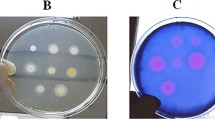Summary
Naturally occurring methicillin-resistant staphylococci were tested for resistance againstΒ-lactam-antibiotics on Bacto-Peptone-Nutrient-Agar (DIFCO), Proteose-Peptone-Nutrient-Agar (DIFCO), Nutrient-Agar (BBL), Brain-Heart-Infusion-Agar (DIFCO) and Mueller-Hinton-Agar (BBL).
The “basic resistance” of the tested strains as well as the “minimal inhibitory concentration∝ (MIC), determined with the agar dilution method, differed tenfold with these media. In a similar way the results of disc diffusion tests became influenced by the medium used. Therefore, besides the inoculum and other factors the nature of the medium also contribute to the difficulty to relate the results of in vitro tests to the action of penicillinase-resistantΒ-lactam-antibiotics in a staphylococcal lesion.
The addition of NaCl (1 M) to nutrient media enhanced the resistance of staphylococci toΒ-lactam-antibiotics. However the heterogeneity of populations of these strains did not disappear.
Subletal concentrations of ethylendiamine-tetra-acetic-acid (EDTA) did not influence the methicillin-resistance of naturally occurring strains and of strains, which developed resistance in vitro. However the addition of Mg2+ ions to the medium reduced the resistance of both kinds of strains.
Zusammenfassung
Die in vitro gemessene Höhe der Resistenz natürlich vorkommender Staphylokokken gegen dieΒ-Lactam-Antibiotica wird stark von der Art des Nährbodens (Bacto-Pepton-Nähragar; Proteose-Pepton-Nähragar; BBL-Nähragar; Brain-Heart-Infusion Agar; Mueller-Hinton-Agar) bestimmt. Dieser Einfluß des Nährbodens Äußert sich sowohl bei Bestimmung der „Grundresistenz“, als auch bei Ermittlung der Resistenz im Reihenverdünnungstest sowie im Papierblättchentest. Dadurch kann die Resistenzhöhe je nach Art des Testes um den Faktor 10 variieren. Zu den die Höhe der Methicillinresistenz natürlicher Staphylokokken stark beeinflussenden Faktoren (Inokulumgröße, Art des Testes) zählt deshalb auch das Nährmedium. Ergebnisse von Reagensglasversuchen können also aufgrund dieser Versuchsparameter stark variieren. Sie haben deshalb nur eine beschränkte Aussagekraft für das Verhalten der Erreger am Infektionsort. Durch Zusatz von 1 M NaCl zum Medium wird die Resistenz natürlich vorkommender Stämme gegenΒ-Lactam-Antibiotica stark gesteigert. Die Heterogenität von Kulturen dieser Stämme verschwindet dadurch jedoch nicht. Die Resistenz künstlich resistent gemachter Stämme dagegen wird durch NaCl nur unwesentlich beeinflußt.
Subletale Konzentrationen von Äthylendiamintetraacetat im Nährmedium beeinflussen die Methicillinresistenz natürlicher und künstlicher Stämme nicht. Durch MgSO4 (10−1 M und 10−2 M) dagegen nimmt die Resistenz stark ab.
Similar content being viewed by others
Literatur
Barber, M.: Naturally occurring methicillin resistant staphylococci. J. gen. Microbiol.35, 183 (1964).
Benner, E. J., and F.-H.Kayser: The burgeoning clinical significance of methicillinresistant Staphylococcus aureus. Lancet (in press).
Bennett, J., J. C. Brodie, E. J. Benner, andW. M. M. Kirby: Simplified, accurate method for antibiotic assay of clinical specimens, Appl. Microbiol.14, 170 (1966).
Chabbert, Y.-A.: Behaviour of “methicillin hetero-resistant” staphylococci to cephaloridine. Postgrad. med. J. Suppl., Vol.43, 40 (1967).
Churcher, G. M.: A screening test for the detection of methicillin-resistant staphylococci. J. clin. Path.21, 213 (1968).
Courtieu, A. L., F. N. Guillermet, C. Longeray, G. Maka etY. A. Chabbert: Fréquence des staphylocoques présentant une résistance hétérogène a la méthicillin et l'oxacilline en milieu hospitalier. Ann. Inst. Pasteur107, 691 (1964).
Dyke, K. G. H., M. P. Jevons, andM. T. Parker: Penicillinase production and intrinsic resistance to penicillins in Staphylococcus aureus. Lancet1966 I, 835.
Kayser, F.-H.: über die Oxacillinresistenz pathogener Staphylokokken. III. Der Mechanismus der Entstehung resistenter Stämme in vivo. Z. med. Mikrobiol. u. Immunol.153, 31 (1966).
—: über die Oxacillinresistenz pathogener Staphylokokken. IV. Vorkommen und Bedeutung von Staphylokokkenstämmen mit „inhärenter Penicillin-resistenz“. Z. med. Mikrobiol. u. Immunol.153, 48 (1966).
—: Zur Resistenzprüfung der Staphylokokken gegen Penicillinasefeste Penicilline und Cephalosporine. Path. et Microbiol. (Basel)30, 381 (1967).
- Die Penicillin- und Cephalosporinresistenz der Staphylokokken. 5. Intern. Kongr. Chemoth. 1967, Wien, p. 65.
—, u.U. Wiemer: über die Oxacillinresistenz pathogener Staphylokokken. I. Die Natur der Resistenz gegen Oxacillin bei Staphylokokken pyog. aureus. Z. Hyg. Infekt.-Kr.150, 308 (1965).
Reyn, A., M. W. Bentzon, andH. Ericsson: Comparative investigations of the sensitivity of N. gonorrhoeae to penicillin. Acta path. microbiol. scand.57, 235–255 (1963).
Sutherland, R., andG. N. Robinson: Characteristics of methicillin-resistant staphylococci. J. Bact.87, 887 (1964).
Turner, G. C., andP. E. Cox: Resistance to cloxacillin among hospital staphylococci. J. clin. Path.20, 870 (1967).
Author information
Authors and Affiliations
Rights and permissions
About this article
Cite this article
Kayser, F.H. Der Einfluß des Nährmediums auf die Methicillinresistenz pathogener Staphylokokken. Z. med. Mikrobiol. u. Immunol. 154, 287–299 (1969). https://doi.org/10.1007/BF02161471
Received:
Issue Date:
DOI: https://doi.org/10.1007/BF02161471




